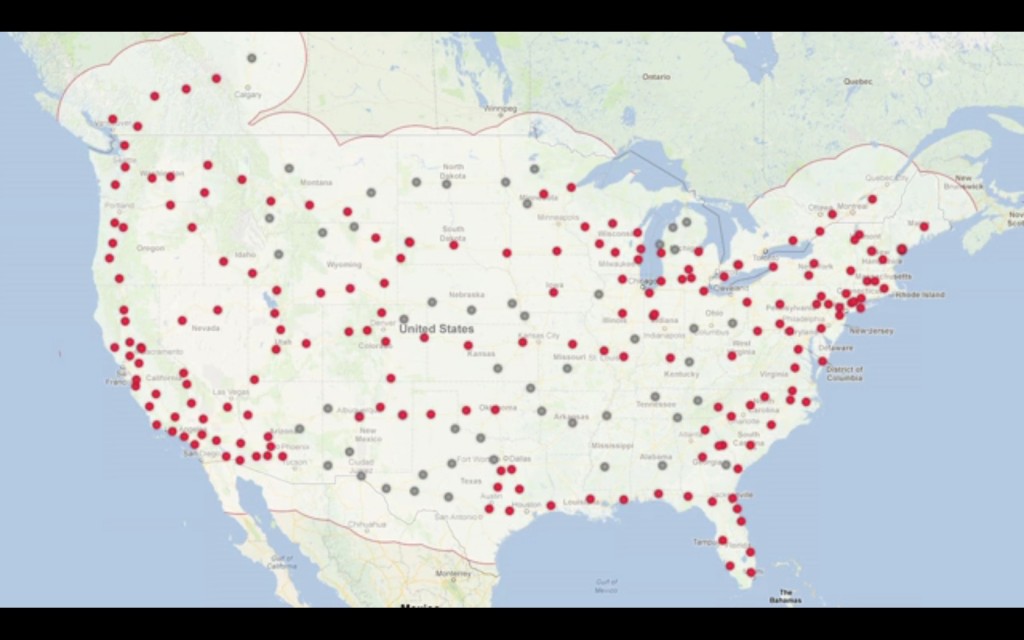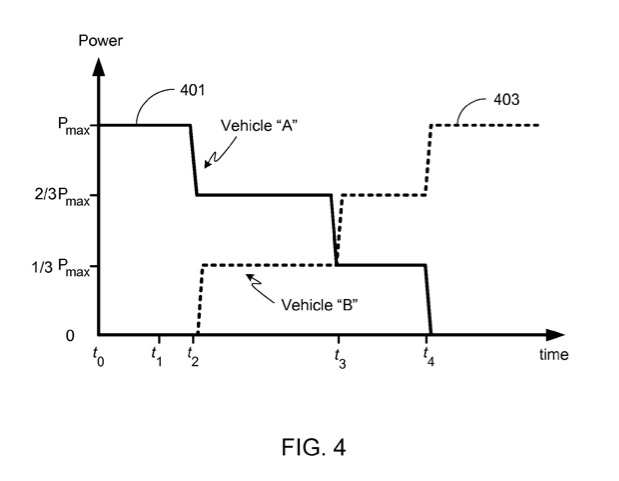
Tesla Motors Supercharger Network In 2015 - released May 2013
This past week–almost exactly 500 days after Tesla Motors announced the first six stations in its Supercharger network–a father-daughter team in a Tesla Model S electric car became the first to cross the country by Supercharger alone.
MORE: Elon Musk Talks Tesla Model X Details, Model S Upgrades, At Europe Q+A Sessions
And Tesla's recent patent filings may give some idea of what the next 500 days might bring.
US Patent Application 2013/0057209, titled "Multiport Vehicle DC Charging System with Variable Power Distribution", looks particularly apropos.

Diagram, Tesla Motors US Patent Application 2013/0057209,
The document anticipates a world where cross-country trips are common enough that Tesla's charging stations may need to juggle who gets how much power, based on factors that may include:
- arrival time ("first-come-first-served")
- priority information (perhaps certain models might get priority?)
- battery state of charge (who needs it most)
- intended departure time (who can afford to wait)
One way this juggling could take place is illustrated in Figure 4, reproduced here.
Vehicle A arrives at the charging station at time t0 and begins charging at maximum power (Pmax). After Vehicle B is connected, and as Vehicle A approaches a full charge, the station gradually shifts power to the new vehicle.
Juggling customer needs
To be clear, this is only one of many ways Tesla could balance different customers' needs at its Superchargers. It can be safely assumed that the company is putting significant thought into its customers' recharging experience, because a different team of Tesla engineers filed the related U.S. Patent Application 2013/0307475.
![2013 Tesla Model S at Supercharger station on NY-to-FL road trip [photo: David Noland] 2013 Tesla Model S at Supercharger station on NY-to-FL road trip [photo: David Noland]](https://images.hgmsites.net/lrg/2013-tesla-model-s-at-supercharger-station-on-ny-to-fl-road-trip-photo-david-noland_100454646_l.jpg)
2013 Tesla Model S at Supercharger station on NY-to-FL road trip [photo: David Noland]
This one, titled "Charge Rate Optimization", describes how a control system could determine whether a charging station should recharge a vehicle at maximum speed or at a gentler rate. The applicants mention some of the items from the earlier document among reasons that a car might be recharged at less-than-top speed, and include one more:
- When it's cold, a heater might warm the battery system up to the optimum recharging temperature, before charging at a reduced rate (this could help prolong the battery's lifetime)
The most interesting aspect of this second patent application is the suggestion that the charging station could determine the optimum recharging protocol after interfacing with a driver through a "portable electronic device" to find out where they need to go, and by when.
If another vehicle arrives in need of a more urgent recharge, the station could contact the affected drivers to ask if a small delay in their schedule might be acceptable.
Which suggests that the Tesla Model S smartphone app--and the Superchargers themselves--might get a lot smarter, someday soon.
Follow-up not patently obvious
Before imagining mockups of future Tesla Superchargers that incorporate 17-inch display screens, cloud computing, and a cure for cancer, it's worth remembering that not all patent applications become full-fledged patents--and that even if a company obtains a patent, it may not act on it.
![2013 Tesla Model S at Supercharger station in Woodburn, Oregon, Nov 2013 [photo: George Parrott] 2013 Tesla Model S at Supercharger station in Woodburn, Oregon, Nov 2013 [photo: George Parrott]](https://images.hgmsites.net/lrg/2013-tesla-model-s-at-tk-nov-2013-photo-george-parrott_100449151_l.jpg)
2013 Tesla Model S at Supercharger station in Woodburn, Oregon, Nov 2013 [photo: George Parrott]
Companies sometimes file so-called "defensive patents" to describe ideas they may follow up with in the future, thereby preventing other companies from blocking their ability to do so.
When it comes to its Superchargers–one of Tesla's key differentiators–we can reasonably expect the company to reinvest in the technology and continue to improve it.
But it remains to be seen whether near-term improvements will incorporate any ideas from the patent applications above.
Either way, the two documents underscore Tesla's efforts, similar to those of its Bay Area neighbor Apple, to improve all aspects of its customers' experience--and plan for a significant surge in the number of those customers.
_______________________________________________











